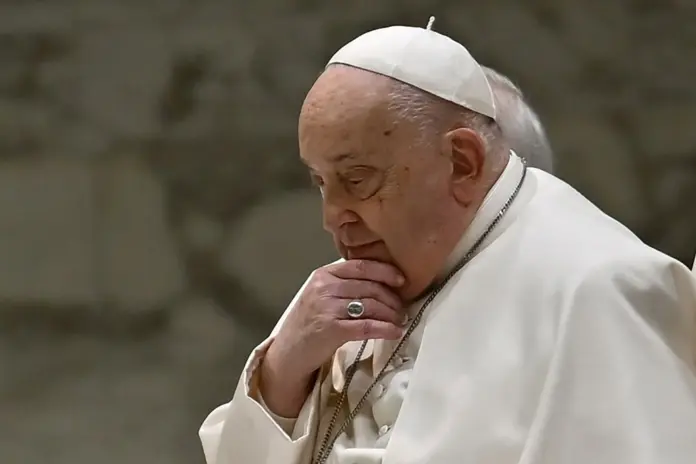Pope Francis, aged 88 and Pope of the Catholic Church, remains in critical condition after suffering a severe asthmatic respiratory attack. The Vatican confirmed that Pope Francis was treated with high-flow oxygen therapy and transfusions of blood for a significant drop in platelets. Although he remains conscious and awake, his condition has caused shockwaves globally.
A Health Crisis That Shook the Vatican
On February 14, Pope Francis was admitted to Rome’s Gemelli Hospital where he developed critical breathing difficulties. He was diagnosed with double pneumonia and initially recovered. His condition took a sharp turn over the weekend when he developed a prolonged respiratory crisis requiring critical care.
The Vatican has informed the public that the Pope remains awake, but only in more discomfort. He goes on to occupy his time by sitting in an armchair, conversing with aides, and giving papal duty as much priority as his own health will allow. The doctors remain guarded, keeping his prognosis under wraps as they closely monitor him for sepsis, a deadly infection of the bloodstream that can manifest as a secondary complication of pneumonia.
Also read: X-37B Space Plane Mission: A New Era of Space Defense
An Outpouring of Prayers Around the World
With news of Pope Francis’s health, prayers and solidarity flowed in from all over the world. From the crowded streets of Mexico City to the silent churches of Argentina, Catholics have prayed in unison for the healing of the Pontiff. On his native continent of Latin America, special masses were held, with believers lighting candles and saying devotions for his well-being.
Even outside of the Catholic sphere, leaders worldwide have sent wishes. The White House released a statement sending its prayers for Pope Francis, and press secretary Karoline Leavitt confirmed former U.S. President Donald Trump was issuing a formal statement. Pope Francis and Trump had been at odds with each other earlier, particularly when it came to immigration policies, so Trump’s anticipated statement came into focus.
Speculations on Resignation and the Vatican’s Response
The health emergency of the Pope has rekindled rumors about a possible resignation. Popes used to stay in office until death, but Pope Benedict XVI set a new precedent by resigning in 2013. Pope Francis himself has already said that he wrote a resignation letter in case he was ever to become medically incapacitated from performing his duties.
But Vatican officials dismissed rumors of his resignation, saying that Pope Francis is well aware, active, and able to make decisions. Vatican Secretary of State Cardinal Pietro Parolin characterized the rumors as “useless,” urging that the attention should be on the recovery of the Pope.
Understanding the Threat of Sepsis
Among the Pope’s most urgent health concerns is developing sepsis, which can be fatal. Sepsis is a life-threatening infection resulting from infection in the bloodstream spread to various regions, producing generalized inflammation and possibly damage to the organs. Because of Pope Francis’ frailty and older age, physicians are exercising extreme vigilance against causing such a catastrophe. No one as of this point has certain proof of developing sepsis, but it is closely being monitored by the experts.
Also read: Who Is Maine’s Governor? Meet Janet Mills & Her Legacy
What If Pope Francis Dies?
The Catholic Church has a highly formalized procedure established in the event of the death of a pope. If Pope Francis were to pass away, his death would be confirmed by the Camerlengo, a senior Vatican official, which would trigger a nine-day mourning period known as the Novendiale. His body would be put on display in St. Peter’s Basilica for the public to see, and thousands of mourners would get an opportunity to pay their respects.
The Vatican would then arrange for a conclave, i.e. when cardinals gather to choose the new pope. Rumors of possible successors have been in the air, but until Pope Francis continued to struggle with the recovery process, the rumors have been premature.
Pope Francis’s History of Hospitalizations and Legacy
Pope Francis has served the Catholic Church since 2013, becoming the successor to Pope Benedict XVI. Throughout his 12 years in office, he has had to be hospitalized several times. In March of 2023, he was hospitalized for bronchitis and in June 2023 was operated on due to a hernia. However, despite his health issues, he has persistently continued spreading his message on social justice, climate change, and world peace.
Conclusion
With the world waiting and praying, Pope Francis’s health remains a cause of deep concern. His unflinching devotion to his beliefs and people has moved millions. Whether he recovers or has more complications, his influence on the Catholic Church and global affairs will remain important.
Meanwhile, patience and prayer have been called for by the Vatican, with information on the health of the Pope expected in a few days.








